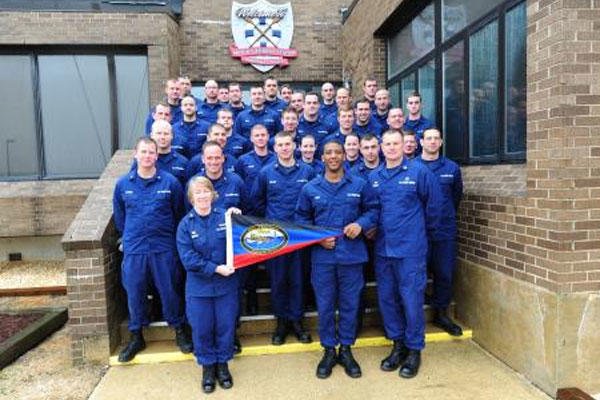The morning of Feb. 11, began with the crew of Coast Guard Station Barnegat Light, N.J., huddled on the beach.
The cold, howling wind and pouring rain set an appropriate tone for the journey into the local life-saving history surrounding Long Beach Island, perhaps one of the most treacherous of New Jersey’s barrier island inlets, where the station is located. This area of the central New Jersey coast suffered nearly 200 shipwrecks within a 10-year period during the 1840s.
The surf station’s crew exists today to provide assistance to boaters who have trouble navigating the strong waves and shifting sands of the inlet.
Chief Warrant Officer Jay Greiner, the station’s commanding officer, wanted to educate his crew of the many significant events that helped shape today’s Coast Guard.
“We want to learn from the past to make the future better,” said Greiner. “That’s our goal.”
Greiner enlisted the help of the unit’s qualified surfmen to speak at each of the historic sites.
The first stop landed the crew on the beach in Ship Bottom. There, Petty Officer 1st Class James Corbisiero, one of the station’s surfmen, explained to his shipmates it was the same location where in August 1839 William A. Newell witnessed the loss of 13 lives when the Austrian-flagged Terasto ran aground about 200 yards offshore. With no way to help the mariners, Newell realized a life-saving station was essential. He went on to serve as a congressman where he lobbied to secure the first meaningful appropriation for a federal life-saving organization in U.S. history. The first appropriation of $10,000 was used to construct the country’s first eight life-saving stations between Sandy Hook and Little Egg Harbor.
Next, the crew visited the mass gravesite of the Powhatan shipwreck victims in Manahawkin. Petty Officer 1st Class Jared Meloro, another unit surfman, educated the crew about the maritime disaster in 1854 where more than 200 people lost their lives offshore from what is now Surf City. This event resulted in the construction of the Absecon Lighthouse and propelled congress to pay salaries to lifeboat station keepers who previously served on a volunteer basis. Two superintendents, one for New Jersey and one for New York, were also paid to oversee the keepers.
The crew then traveled to a cemetery in Barnegat to visit the gravesites of three fallen surfmen who perished Feb. 11, 1886. Chief petty officer and surfman Patrick Brown discussed the tragedy of their attempted rescue of the Kraljevica crew after a rouge wave overturned their ship off Long Beach Island.
As Brown detailed the large wave that capsized the lifeboat claiming the lives of the three surfmen, a heavy wind blew through the cemetery bringing with it sheets of sideways rain.
“It’s almost like our predecessors – the three surfmen who passed away – were actually listening to us and coming down to say hello,” said Greiner. “You could almost feel the chills. I could see it in the eyes of the whole crew. It was like divine intervention.”
The station’s newest crewmember, Seaman Jahred Boyd, said learning about the area’s rich history made him appreciate his new unit.
“It was amazing,” said Boyd. “I learned so much that will help me throughout my career. I can’t even put it into words.”
Corbisiero expressed his appreciation for the unit’s junior members showing such interest in the Coast Guard’s roots.
“It’s very empowering,” said Corbisiero. “You learn a lot being able to pass along the traditions. It’s good for them to understand our history so they can keep it going for generations to come. I think if you don’t know where you came from in your history you’ll just stray off instead of being a team player.”
As a conclusion to the morning, the crew gathered on the station’s mess deck where Greiner showed a video of a 2002 incident in which he was involved. The video showed Greiner as a first class petty officer aboard a motor lifeboat when it overturned off the coast of Oregon. After the rollover, Greiner stepped up, gained control of the boat and brought the crew safely ashore.
“The point of this history lesson today is that it is just as important for us to maintain a high level of mental readiness as it is physical readiness,” said Greiner.
The crew then welcomed Capt. Kathy Moore, commander of Sector Delaware Bay. Moore was there to present the crew with the Sumner I. Kimball Readiness Award. The award is named for Sumner Increase Kimball, recognized by Congress as the general superintendant of the U.S. Life-Saving Service.
“The Sumner I. Kimball Award is a great award to get, and it proves that this unit for a long time has done the right thing every day,” said Greiner. “To be recognized as one of the best units in the Coast Guard is an honor. It feels great.”
Greiner emphasizes the point that he and his crew aren’t about to rest on their laurels.
“That was a snapshot in time,” said Greiner. “We can’t rest on that. We still have to get better. We still have to push our shipmates to get better. It’s a constant evolution of life of always wanting to get better. I’m honored and I’m humbled, but I’m not gonna stop.”




























